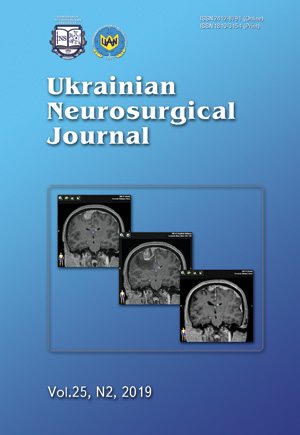Pulsed radiofrequency ablation of the posterior spinal root ganglia (PRF DRG) for the treatment of chronic lumbar radicular pain
DOI:
https://doi.org/10.25305/unj.157002Keywords:
lumbar radicular pain, pulsed radiofrequency ablation, dorsal root ganglionAbstract
Radicular lumbar pain constitutes a significant proportion of the total number of pain syndromes. Conservative treatment of this pathology is effective in 60 % of patients. In other cases, the pain may become chronic, leading to disability. These facts have been a stimulus for the development of minimally-invasive procedures which are sufficiently effective and have a low risk of potential complications. The most common of these is interventional radiofrequency treatment.
The purpose of this study is to investigate the dynamics of pain and social adaptation in patients suffering from chronic lumbar radicular pain, who have been treated with pulsed radiofrequency ablation of the posterior spinal root ganglia (pulsed radiofrequency of dorsal root ganglion, PRF DRG).
Materials and methods. A retrospective study included 42 patients aged from 27 to 78 years (49.7 ± 14.8) who were treated in 2016–2017 at the Neuromed Clinic in Kyiv and the Institute of Traumatology and Orthopedics of NAMS of Ukraine. The study included patients suffering from reactive lumbosacral radicular pain due to degenerative-dystrophic lesions of the spine. Pain syndrome was assessed on a visual analogue scale (VAS) before manipulation, immediately after it, and six months afterwards. Social adaptation in everyday life was objectified using the Oswestry Low Back Pain Disability Questionnaire.
Results. No complications were registered. Absolutely all patients confirmed a decrease in pain. Before the manipulation, most of the patients described their pain as “very strong” (VAS 7.14 ± 0.68), whilst after the procedure the majority answered that their pain decreased to “average” (VAS 4.02 ± 0.81). A similar trend persisted for six months after treatment (VAS 1.85 ± 0.78). Before manipulation, the index of impairment due to pain (ODI) was 71.42 ± 6.83. Six months after the procedure, the ODI index was 18.57 ± 7.83.
Conclusion. Pulsed radiofrequency of the dorsal spinal ganglia (PRF DRG) is a safe and effective procedure for the treatment of chronic lumbar radicular pain.
References
1. Trinidad JM, Carnota AI, Failde I, Torres LM. Radiofrequency for the Treatment of Lumbar Radicular Pain: Impact on Surgical Indications. Pain Res Treat. 2015;2015:392856. [CrossRef] [PubMed] [PubMed Central]
2. Konstantinou K, Dunn KM. Sciatica: review of epidemiological studies and prevalence estimates. Spine (Phila Pa 1976). 2008 Oct 15;33(22):2464-72. [CrossRef] [PubMed]
3. Weber H. The natural course of disc herniation. Acta Orthop Scand Suppl. 1993;251:19-20. [CrossRef] [PubMed]
4. Bosscher HA, Heavner JE. Incidence and severity of epidural fibrosis after back surgery: an endoscopic study. Pain Pract. 2010 Jan-Feb;10(1):18-24. [CrossRef] [PubMed]
5. Van Boxem K, van Bilsen J, de Meij N, Herrler A, Kessels F, Van Zundert J, van Kleef M. Pulsed radiofrequency treatment adjacent to the lumbar dorsal root ganglion for the management of lumbosacral radicular syndrome: a clinical audit. Pain Med. 2011 Sep;12(9):1322-30. [CrossRef] [PubMed]
6. Van Boxem K, Cheng J, Patijn J, van Kleef M, Lataster A, Mekhail N, Van Zundert J. 11. Lumbosacral radicular pain. Pain Pract. 2010 Jul-Aug;10(4):339-58. [CrossRef] [PubMed]
7. Cosman ER Jr, Cosman ER Sr. Electric and thermal field effects in tissue around radiofrequency electrodes. Pain Med. 2005 Nov-Dec;6(6):405-24. [CrossRef] [PubMed]
8. Erdine S, Bilir A, Cosman ER, Cosman ER Jr. Ultrastructural changes in axons following exposure to pulsed radiofrequency fields. Pain Pract. 2009 Nov-Dec;9(6):407-17. [CrossRef] [PubMed]
9. Kim SJ, Park SJ, Yoon DM, Yoon KB, Kim SH. Predictors of the analgesic efficacy of pulsed radiofrequency treatment in patients with chronic lumbosacral radicular pain: a retrospective observational study. J Pain Res. 2018 Jun 26;11:1223-1230. [CrossRef] [PubMed] [PubMed Central]
10. Van Boxem K, Huntoon M, Van Zundert J, Patijn J, van Kleef M, Joosten EA. Pulsed radiofrequency: a review of the basic science as applied to the pathophysiology of radicular pain: a call for clinical translation. Reg Anesth Pain Med. 2014 Mar-Apr;39(2):149-59. [CrossRef] [PubMed]
11. Mehta V, Snidvongs S, Ghai B, Langford R, Wodehouse T. Characterization of peripheral and central sensitization after dorsal root ganglion intervention in patients with unilateral lumbosacral radicular pain: a prospective pilot study. Br J Anaesth. 2017 Jun 1;118(6):924-931. [CrossRef] [PubMed]
12. Belova AN. Scales, tests and questionnaires in neurology and neurosurgery. Moscow: Antidor; 2004. Russian.
13. Koh W, Choi SS, Karm MH, Suh JH, Leem JG, Lee JD, Kim YK, Shin J. Treatment of chronic lumbosacral radicular pain using adjuvant pulsed radiofrequency: a randomized controlled study. Pain Med. 2015 Mar;16(3):432-41. [CrossRef] [PubMed]
Downloads
Published
How to Cite
Issue
Section
License
Copyright (c) 2019 Borys B. Pavlov, Iakiv V. Fishchenko

This work is licensed under a Creative Commons Attribution 4.0 International License.
Ukrainian Neurosurgical Journal abides by the CREATIVE COMMONS copyright rights and permissions for open access journals.
Authors, who are published in this Journal, agree to the following conditions:
1. The authors reserve the right to authorship of the work and pass the first publication right of this work to the Journal under the terms of Creative Commons Attribution License, which allows others to freely distribute the published research with the obligatory reference to the authors of the original work and the first publication of the work in this Journal.
2. The authors have the right to conclude separate supplement agreements that relate to non-exclusive work distribution in the form of which it has been published by the Journal (for example, to upload the work to the online storage of the Journal or publish it as part of a monograph), provided that the reference to the first publication of the work in this Journal is included.









